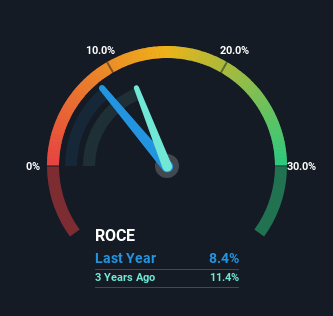The Returns At Canadian Tire Corporation (TSE:CTC.A) Aren't Growing
What trends should we look for it we want to identify stocks that can multiply in value over the long term? Firstly, we'll want to see a proven return on capital employed (ROCE) that is increasing, and secondly, an expanding base of capital employed. Ultimately, this demonstrates that it's a business that is reinvesting profits at increasing rates of return. However, after investigating Canadian Tire Corporation (TSE:CTC.A), we don't think it's current trends fit the mold of a multi-bagger.
Understanding Return On Capital Employed (ROCE)
If you haven't worked with ROCE before, it measures the 'return' (pre-tax profit) a company generates from capital employed in its business. The formula for this calculation on Canadian Tire Corporation is:
Return on Capital Employed = Earnings Before Interest and Tax (EBIT) ÷ (Total Assets - Current Liabilities)
0.084 = CA$1.3b ÷ (CA$22b - CA$6.7b) (Based on the trailing twelve months to March 2024).
Thus, Canadian Tire Corporation has an ROCE of 8.4%. In absolute terms, that's a low return and it also under-performs the Multiline Retail industry average of 11%.
View our latest analysis for Canadian Tire Corporation
Above you can see how the current ROCE for Canadian Tire Corporation compares to its prior returns on capital, but there's only so much you can tell from the past. If you'd like, you can check out the forecasts from the analysts covering Canadian Tire Corporation for free.
So How Is Canadian Tire Corporation's ROCE Trending?
Things have been pretty stable at Canadian Tire Corporation, with its capital employed and returns on that capital staying somewhat the same for the last five years. It's not uncommon to see this when looking at a mature and stable business that isn't re-investing its earnings because it has likely passed that phase of the business cycle. So don't be surprised if Canadian Tire Corporation doesn't end up being a multi-bagger in a few years time. This probably explains why Canadian Tire Corporation is paying out 49% of its income to shareholders in the form of dividends. Unless businesses have highly compelling growth opportunities, they'll typically return some money to shareholders.
Our Take On Canadian Tire Corporation's ROCE
We can conclude that in regards to Canadian Tire Corporation's returns on capital employed and the trends, there isn't much change to report on. And with the stock having returned a mere 14% in the last five years to shareholders, you could argue that they're aware of these lackluster trends. Therefore, if you're looking for a multi-bagger, we'd propose looking at other options.
One more thing: We've identified 4 warning signs with Canadian Tire Corporation (at least 1 which is significant) , and understanding them would certainly be useful.
While Canadian Tire Corporation may not currently earn the highest returns, we've compiled a list of companies that currently earn more than 25% return on equity. Check out this free list here.
Have feedback on this article? Concerned about the content? Get in touch with us directly. Alternatively, email editorial-team (at) simplywallst.com.
This article by Simply Wall St is general in nature. We provide commentary based on historical data and analyst forecasts only using an unbiased methodology and our articles are not intended to be financial advice. It does not constitute a recommendation to buy or sell any stock, and does not take account of your objectives, or your financial situation. We aim to bring you long-term focused analysis driven by fundamental data. Note that our analysis may not factor in the latest price-sensitive company announcements or qualitative material. Simply Wall St has no position in any stocks mentioned.
Have feedback on this article? Concerned about the content? Get in touch with us directly. Alternatively, email editorial-team@simplywallst.com

 Yahoo Finance
Yahoo Finance 
